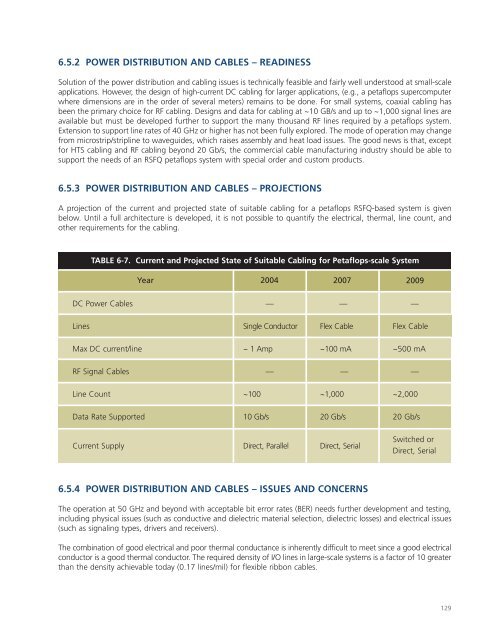Superconducting Technology Assessment - nitrd
Superconducting Technology Assessment - nitrd
Superconducting Technology Assessment - nitrd
You also want an ePaper? Increase the reach of your titles
YUMPU automatically turns print PDFs into web optimized ePapers that Google loves.
6.5.2 POWER DISTRIBUTION AND CABLES – READINESS<br />
Solution of the power distribution and cabling issues is technically feasible and fairly well understood at small-scale<br />
applications. However, the design of high-current DC cabling for larger applications, (e.g., a petaflops supercomputer<br />
where dimensions are in the order of several meters) remains to be done. For small systems, coaxial cabling has<br />
been the primary choice for RF cabling. Designs and data for cabling at ~10 GB/s and up to ~1,000 signal lines are<br />
available but must be developed further to support the many thousand RF lines required by a petaflops system.<br />
Extension to support line rates of 40 GHz or higher has not been fully explored. The mode of operation may change<br />
from microstrip/stripline to waveguides, which raises assembly and heat load issues. The good news is that, except<br />
for HTS cabling and RF cabling beyond 20 Gb/s, the commercial cable manufacturing industry should be able to<br />
support the needs of an RSFQ petaflops system with special order and custom products.<br />
6.5.3 POWER DISTRIBUTION AND CABLES – PROJECTIONS<br />
A projection of the current and projected state of suitable cabling for a petaflops RSFQ-based system is given<br />
below. Until a full architecture is developed, it is not possible to quantify the electrical, thermal, line count, and<br />
other requirements for the cabling.<br />
TABLE 6-7. Current and Projected State of Suitable Cabling for Petaflops-scale System<br />
Year 2004 2007<br />
2009<br />
DC Power Cables<br />
—<br />
—<br />
—<br />
Lines<br />
Single Conductor<br />
Flex Cable<br />
Flex Cable<br />
Max DC current/line<br />
~ 1 Amp<br />
~100 mA<br />
~500 mA<br />
RF Signal Cables<br />
—<br />
—<br />
—<br />
Line Count<br />
~100<br />
~1,000<br />
~2,000<br />
Data Rate Supported<br />
10 Gb/s<br />
20 Gb/s<br />
20 Gb/s<br />
Current Supply<br />
Direct, Parallel<br />
Direct, Serial<br />
Switched or<br />
Direct, Serial<br />
6.5.4 POWER DISTRIBUTION AND CABLES – ISSUES AND CONCERNS<br />
The operation at 50 GHz and beyond with acceptable bit error rates (BER) needs further development and testing,<br />
including physical issues (such as conductive and dielectric material selection, dielectric losses) and electrical issues<br />
(such as signaling types, drivers and receivers).<br />
The combination of good electrical and poor thermal conductance is inherently difficult to meet since a good electrical<br />
conductor is a good thermal conductor. The required density of I/O lines in large-scale systems is a factor of 10 greater<br />
than the density achievable today (0.17 lines/mil) for flexible ribbon cables.<br />
129














